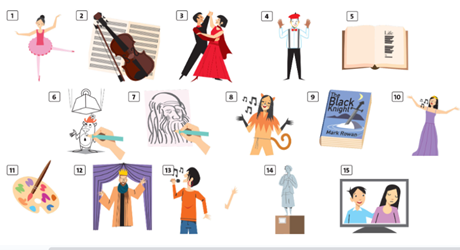7A. Vocabulary - Unit 7. Artists - SBT Tiếng Anh 11 Friends Global
1. Complete the art forms. 2. Complete the sentences with types of artist. 3. Listen to three speakers talking about art forms that they study. Match speakers 1-3 with sentences A-D. There is one extra sentence.
Bài 1
Talking about the arts.
I can talk about the arts.
1. Complete the art forms.
(Hoàn thiện các loại hình nghệ thuật.)
1 b__________
2 c__________ m__________
3 d__________
4 m__________
5 p__________
6 c__________
7 d__________
8 m__________
9 n__________
10 o__________
11 p__________
12 p__________
13 p__________ m__________
14 s__________
15 s__________

Lời giải chi tiết:
1 ballet: múa ba lê
2 classical music: nhạc cổ điển
3 dance: nhảy
4 mime: kịch câm
5 poem: thơ
6 cartoon: hoạt hình
7 drawing: vẽ
8 musical: nhạc
9 novel: tiểu thuyết
10 opera: hát opera
11 painting: vẽ tranh
12 play: kịch
13 pop music: nhạc pop
14 sculpture: điêu khắc
15 sitcom: phim sitcom
Bài 2
2. Complete the sentences with types of artist.
(Hoàn thành các câu với các loại nghệ sĩ.)
1 A playwright writes plays.
(Một nhà viết kịch viết kịch.)
2 _________ choreographs dances.
3 _________ performs in operas.
4 _________ directs films and plays.
5 _________ sings in a band.
6 _________ conducts an orchestra.
7 _________ paints pictures.
8 _________ acts in plays and films.
9 _________ writes novels.
10 _________ carves statues and creates sculptures.
Lời giải chi tiết:

2 A choreographer choreographs dances.
(Một biên đạo múa biên đạo các điệu nhảy.)
3 An opera singer performs in operas.
(Một ca sĩ opera biểu diễn trong vở opera.)
4 A director directs films and plays.
(Đạo diễn chỉ đạo phim và kịch.)
5 A pop singer sings in a band.
(Một ca sĩ nhạc pop hát trong một ban nhạc.)
6 A conductor conducts an orchestra.
(Một nhạc trưởng chỉ huy một dàn nhạc.)
7 A painter paints pictures.
(Một họa sĩ vẽ tranh.)
8 An actor acts in plays and films.
(Diễn viên đóng kịch và đóng phim.)
9 A novelist writes novels.
(Một tiểu thuyết gia viết tiểu thuyết.)
10 A sculptor carves statues and creates sculptures.
(Một nhà điêu khắc tạc tượng và tạo ra tác phẩm điêu khắc.)
Bài 3
3. Listen to three speakers talking about art forms that they study. Match speakers 1-3 with sentences A-D. There is one extra sentence.
(Hãy nghe ba diễn giả nói về các loại hình nghệ thuật mà họ nghiên cứu. Nối người nói từ 1-3 với câu A-D. Có một câu bị thừa.)
Which speaker …
A already earns some money from his / her artistic skills? ☐
B describes an old and a new artistic skill that have a connection with each other? ☐
C wants to experiment with different performance ideas in his / her chosen art form? ☐
D says that his / her art form is not appreciated by many people? ☐
Phương pháp giải:
Bài nghe
Interviewer: You’re a dance student, aren’t you, Ella? What kind of dance do you study and why?
Ella: I’m training as a ballet dancer, but I also study music. I love the movement of dance combined with the music. When a ballet is performed, the music plays such an important role. Some of the great classical composers wrote wonderful music just for dance.
Interviewer: What kind of dance career do you hope to have in the future?
Ella: I would like to work in a small, modern company where new combinations of dance and music are created. And I would like to choreograph ballets as well as perform them.
2
Interviewer: Zak, you study at a school for the performing arts. What kind of career would you like?
Zak: Well, I can’t choose between acting and singing, but fortunately musicals are back in fashion now. And now they are being produced by big film studios. Many Hollywood stars can act and sing. Look at Meryl Streep. She’s an Oscar winning actor. But she also sings wonderfully in Mamma Mia!, a musical based on ABBA songs.
Interviewer: But what if you don’t make it big in Hollywood films?
Zak: Well, in Britain and America there is a strong theatre tradition. You have Broadway in New York and the West End in London, where musicals are performed every night of the year. I would love to appear in one of those musicals.
3
Interviewer: Mandy, you study music at university. What exactly?
Mandy: My specialised subject is singing. I study opera and operatic composers mainly, but we also look at other areas of singing – traditional folk music and tribal singing. Singing is seen as the oldest art form. And I also sing, of course!
Interviewer: What sort of singing do you do?
Mandy: I sing in two choirs – a huge church choir and a small jazz choir. And I also sing in the evenings at a restaurant near the university, where I’m very well-paid. It helps me pay my university fees, and it’s good practice for me.
Interviewer: What would you like to do in the future?
Mandy: I don’t mind, as long as it’s some form of singing. One day, I’d also like to compose my own songs.
Tạm dịch
Lời giải chi tiết:

Which speaker…
(Người nói nào…)
A already earns some money from his / her artistic skills?
(đã kiếm được tiền từ kỹ năng nghệ thuật của mình chưa?)
Thông tin: “I also sing in the evenings at a restaurant near the university, where I’m very well-paid.”
(Tôi cũng hát vào buổi tối tại một nhà hàng gần trường đại học, nơi tôi được trả lương rất cao.)
=> Speaker 3
B describes an old and a new artistic skill that have a connection with each other?
(mô tả kỹ năng nghệ thuật cũ và mới có mối liên hệ với nhau?)
Thông tin: “but fortunately musicals are back in fashion - I would love to appear in one of those musicals.”
(nhưng may mắn thay nhạc kịch đã trở thành mốt - Tôi rất muốn xuất hiện trong một trong những vở nhạc kịch đó.)
=> Speaker 2
C wants to experiment with different performance ideas in his / her chosen art form?
(muốn thử nghiệm những ý tưởng biểu diễn khác nhau trong loại hình nghệ thuật mà mình đã chọn?)
Thông tin: “I would like to work in a small, modern company where new combinations of dance and music are created.”
(Tôi muốn làm việc trong một công ty nhỏ, hiện đại, nơi tạo ra sự kết hợp mới giữa khiêu vũ và âm nhạc.)
=> Speaker 1
D says that his / her art form is not appreciated by many people?
(nói rằng loại hình nghệ thuật của anh/cô ấy không được nhiều người đánh giá cao?)
Không có thông tin người nói phù hợp
Bài 4
4. Complete the sentences with the verbs below. Then listen again and check.
(Hoàn thành câu với các động từ dưới đây. Sau đó nghe lại và kiểm tra.)

Speaker 1
And I would like to _________ ballets as well as _________ them.
Speaker 2
a Firstly, I love _________ sculptures out of wood.
b I’m also fascinated by 3D modelling, where you _________ 3D models.
Speaker 3
a I _________ in two choirs.
b One day, I’d also like to _________ my own songs.
Phương pháp giải:
*Nghĩa của các động từ
carving (v): chạm khắc
choreograph (v): biên đạo múa
compose (v): biên soạn
create (v): tạo ra
perform (v): trình diễn
sing (v): hát
Lời giải chi tiết:

Speaker 1
(Người nói 1)
And I would like to choreograph ballets as well as perform them.
(Và tôi muốn biên đạo múa ba-lê cũng như biểu diễn chúng.)
Speaker 2
(Người nói 2)
a Firstly, I love carving sculptures out of wood.
(Thứ nhất, tôi thích chạm khắc các tác phẩm điêu khắc bằng gỗ.)
b I’m also fascinated by 3D modelling, where you create 3D models.
(Tôi cũng bị mê hoặc bởi mô hình 3D, nơi bạn tạo mô hình 3D.)
Speaker 3
(Người nói 3)
a I sing in two choirs.
(Tôi hát trong hai dàn hợp xướng.)
b One day, I’d also like to compose my own songs.
(Một ngày nào đó, tôi cũng muốn sáng tác những bài hát của riêng mình.)
Search google: "từ khóa + timdapan.com" Ví dụ: "7A. Vocabulary - Unit 7. Artists - SBT Tiếng Anh 11 Friends Global timdapan.com"







